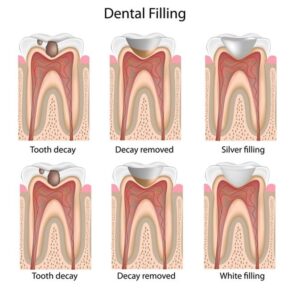Our bodies are composed of various parts, each with distinct roles to play. Some parts may be viewed as more important than others, and it’s rightfully so. We have heard countless times about other important parts, but the teeth haven’t received sensitization like other parts. Teeth are an essential asset and taking good care of them is important. They may have various deformities and defects, some happening naturally, others as a result of neglect. Today we address one method that is used to save teeth from loss, through dental filling treatment.
What is a dental filling?
Tooth fillings are a single or combination of metals, plastics, glass or other materials used to repair and restore teeth. They are used in the treatment of cavities and dental carriers, (commonly known as tooth decay). Dental fillings are also used to repair cracked or broken teeth. Fillings also repair teeth that have been worn down by misuse such as tooth grinding. They help prevent further damage to the tooth while also restoring it to its normal shape and structure. In addition to this, they enable the treated tooth to resume normal functions, just like a healthy tooth.
How do I know if I need a dental filling?
Dental filling treatments are used to repair damaged teeth. If you notice small holes forming on your teeth, it is probably cavities developing. This is one sign that you need to visit your dentist at the sterling dental clinic. If unchecked, the cavities grow deeper into the tooth, to form tooth decay. Tooth decay also necessitates one to be checked. Tooth filling would be a suitable treatment for tooth decay. Moreover, if your teeth are cracked, chipped or broken, having them filled is the wisest choice to take.

Who should I see when in need of a dental filling?
Have you noticed any of the above conditions? Do you feel you need a dental filling done on your teeth? Maybe you need a check-up to determine if you are fit for tooth filling. If you’re in one of these scenarios, then you should consider seeing a dentist or better still an endodontist. The best place to visit for this is the Nairobi sterling dental clinic. At the sterling dental clinic, we have the best dentists and endodontists in the region. we also have cutting-edge tooth rehabilitation procedures at your disposal.
What is the structure of the tooth?
The physical structural part of the tooth consists of a white layer called enamel and a hard layer called dentin. Below the dentine, is a soft layer called the pulp. The pulp is made up of blood vessels, nerves and connective tissues. The dentine and enamel, form the crown region of the tooth. Infections on the tooth lead to an attack on the enamel by germs and bacteria. They damage the tooth, forming tiny holes or cracks to form cavities. Cavities may, later on, lead to tooth decay. A tooth filling is done on the crown section of the tooth to save it from loss.
How popular is a dental filling?
Tooth filling treatments are some of the most popular dental procedures done worldwide. It is estimated that over 200 million dental filling procedures are done in a year across the world. This is no mean fit for a dental procedure. Tooth decay is the most popular cause that may require one to seek dental filling treatment. Cavities are also ranked among the highest causes.
What are the types of dental fillings?
There are several types of tooth fillings available today. These are:
- Amalgam fillings- These are silver-coloured fillings. They are made of a combination of silver, mercury, tin and copper. They are more durable than tooth-colour fillings and are more affordable. Amalgam fillings are shiny and some people do not prefer them for teeth in conspicuous areas. Others may take issues with the level of mercury content in the tooth filling, but the ADA has cleared it for use, deeming it safe. There is no clinical evidence of any harm caused by amalgam fillings.
- Glass ionomer fillings- They are also tooth-coloured fillings, made of acrylic and a special type of glass containing fluoride. The fluoride component of the filling helps prevent cavities in the tooth. They are however not as strong as the composites and are mainly used on children’s teeth.
- Composite fillings- They are also called white-tooth colour fillings. This is because they are matched to the colour of the tooth, making them appear more natural. They are composed of a mixture of glass, quartz particles and acrylic resin. This material is also durable, but a little bit more expensive than amalgam fillings.
- Porcelain fillings- They are also called indirect fillings or inlays/ Onlays. They are also custom-made in the lab, after the dentists take an impression of the affected tooth, and then bond them with the tooth. These fillings are made to fit our tooth colour and are more resistant to staining. They are however more expensive, costing as much as gold does.
- Gold fillings- this is a mixture of gold, copper and other metals. They are well tolerated by the gums, and are durable, lasting up to 10 years. Gold fillings are however the most expensive to get. They are generally custom-made in the labs after the dentist takes an impression of the affected tooth. They are however not natural looking.
What happens at the dental clinic during dental filling?
Sterling dental clinic is a centre for professionalism and quality services. We, therefore, conduct our services with this in mind as our guiding rule. Part of this professionalism involves following the right processes as one gets treatment. We start our treatment with a dental consultation with our endodontists. The specialist performs a physical examination of your teeth to assess the damage caused to them. He then takes a visualization of your mouth using our digital dental X-rays. X-ray images help him know details that he couldn’t decipher from the physical check. The specialist then creates a model of your teeth, for use in further treatment.
Based on the results and findings, the endodontist forms a medical report on the matter and makes a diagnosis. He discusses these findings with you and engages you in an impactful conversation on dental health and the nature of your condition. He also advises you on the right treatment procedure to seek. If you are suitable for a dental filling, he then books you for the procedure.
How is the treatment done?
The procedure is done on an outpatient basis, at our clinic. It begins with the specialist using a small amount of numbing agent on the area to be treated. They then apply local anaesthesia to prevent the patient from experiencing pain and enhance comfort. The specialist then uses a drill or air abrasion instrument on the enamel to eliminate the decayed area. In instances where the decay has reached the dentine, a slower, rounder and less powerful drill is used. This is done to avoid harming the sensitive dentine.
The endodontist checks the area during decay removal to ensure all the decay has been extracted. He then prepares the space for filling by cleaning the cavity, to kill the bacteria and extract all debris. If the cavity or decay has reached the root, the specialist may use a liner to protect the nerves. The liner is made of glass ionomer, composite resin or other material. The filling material is then placed in the cleaned section in layers. A special blue wavelength laser is used to cure and harden the filling layers.
The client’s comfortability is one primal aspect of the procedure. We have to ensure that the filling is at the right level. To restore normal bite and comfortability, the excess material will be trimmed off. Once the ideal level is arrived at, the filling is polished and the patient is discharged. The choice of instrument used depends on the medic’s comfortability, location and extent of the decay. Our clinic however has all equipment available, and our dentists will choose their preferred device.

How long does the treatment last?
A dental filling procedure takes about 30 to 90 minutes at the clinic. This depends on the type and extent of the defect. The pace also depends on the location of the tooth being treated and its accessibility. We have to ensure we show high precision to avoid harming other healthy teeth. This may also affect the duration of the treatment.
Are dental fillings durable?
Yes. All dental fillings are durable. The period of duration is however dependent on the type of filling. Gold fillings can last up to 10 years, while amalgam fillings last for up to 20 years and more. The duration also depends on how well one takes care of their teeth after treatment. The endodontist shares some care and precaution measures to observe to ensure the longevity of your fillings. Adhering to these measures saves your tooth and ensures your fillings serve you longer.
Are dental fillings safe?
Yes. Dental fillings are safe for use. They have been clinically tested and approved for use. There is controversy surrounding the use of amalgam fillings, with factions against it citing its dangers. Amalgam fillings contain mercury and other components. The ADA and FDA have however downplayed these claims and said the treatment is safe for use. They, however, advised that the amalgam filling be used with care. In addition, the medical specialist shouldn’t allow them for members of a high-risk group. These include pregnant or nursing women.
I’m I a good candidate for tooth filling?
Dental fillings can be done on anyone, irrespective of gender and age. Anyone can be a good candidate. One should however consult with our endodontist or dentist to know if they are suitable for treatment. Due to controversy and safety precautions around some types of fillings, we do not recommend amalgam filling to people perceived to be part of a high-risk group. This group consist of pregnant and breastfeeding women, newborn babies, and children under 6 years old. People with neurological diseases such as Parkinson’s disease or multiple sclerosis also fall here. Moreover, people with allergies to mercury and patients with impaired kidney functions are also high-risk patients.
How do I take care of my teeth after fillings?
Ensure that you honour your visit to your dental specialist for regular cleaning. Brushing with fluoride toothpaste and regular flossing also helps save your teeth. One is advised to eat soft foods and avoid sugary foods. You should also ensure you protect your teeth from an injury such as hard impacts. After filling, may experience some sensitivity as the tooth heals. You are recommended to avoid actions or substances that make your teeth sensitive, such as hot beverages or hard chewing. Consult with your dentist if your tooth is overly sensitive or painful. You ought to seek a specialist should there be cracks in the filling.
A note from Nairobi sterling dental clinic.
Tooth decay is one of the leading causes of tooth loss. This defect is preventable by following the right oral hygiene. It is also treatable by use of procedures such as tooth filling. Nairobi sterling dental clinic brings you tooth-filling treatment at an affordable cost. We also offer quality and effective services, under the care of qualified and experienced personnel. We are also located at an accessible place, at the Park Suite Building in Parklands, Nairobi. Visits us today at our clinic for treatment or contact our clinic to book an appointment with one of our specialists. Sterling dental clinic, gives you better teeth, better health and better life.

